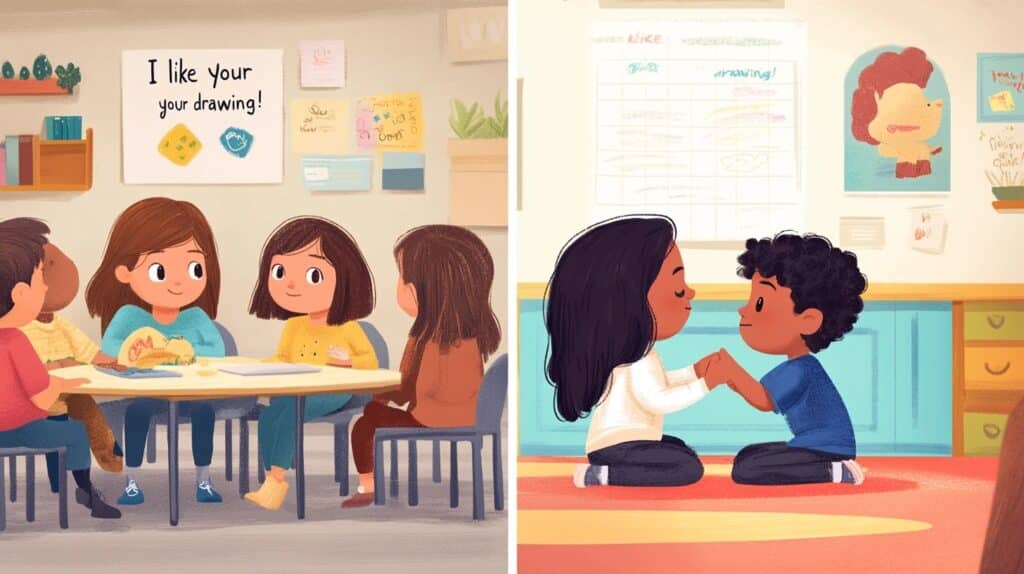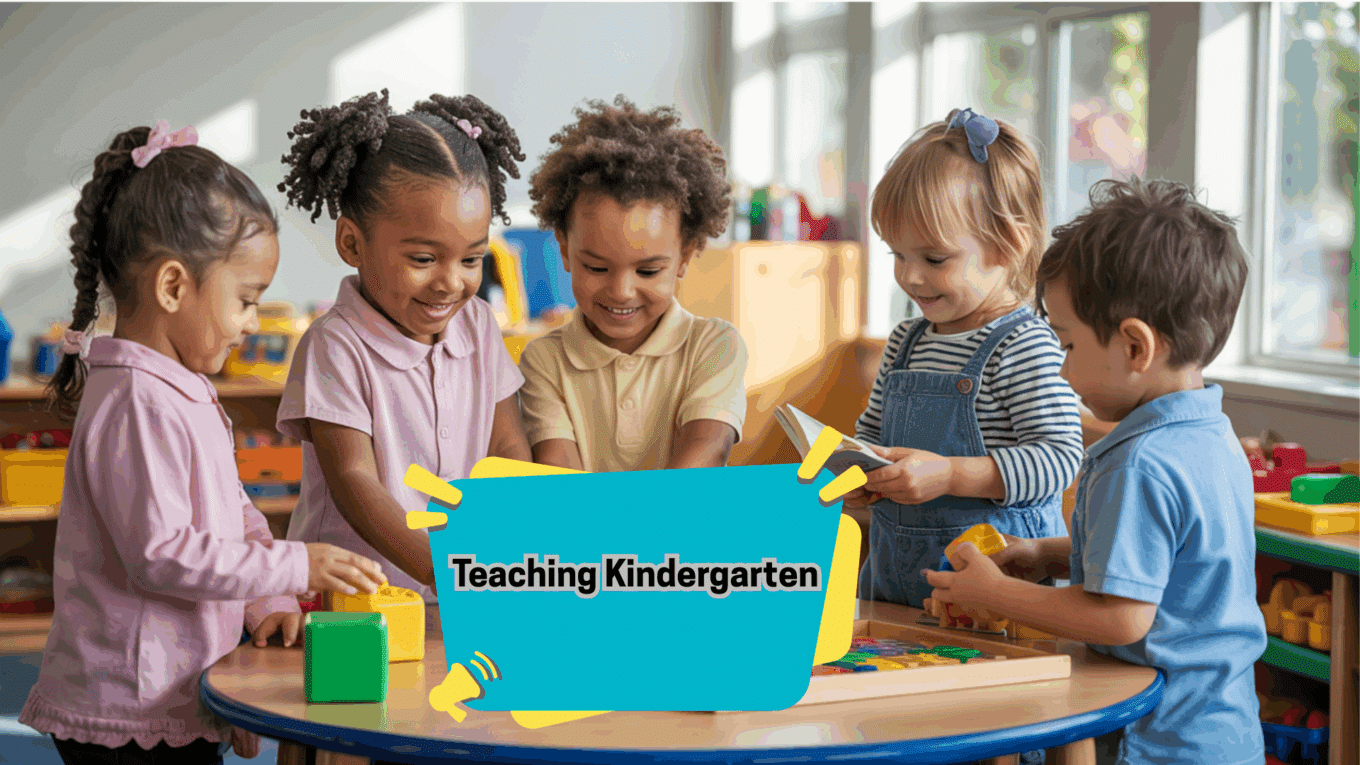Teaching kindergarten can feel exciting, but also overwhelming.
You might be wondering how to keep little kids focused, happy, and learning all day long. It’s a big shift, especially if you’re new to this age group.
The good news? You don’t need to guess. This blog walks you through everything you need to know.
To set up your classroom, what to teach, how to build routines, connect with families, and support each child’s social and emotional growth.
If you’re just starting or switching grades, this blog makes teaching kindergarten feel more doable and a lot more fun.
Keep reading to learn what really works and discover tips that can help your year go smoother from the very first day.
Teaching Kindergarten: What to Know Before You Begin
Kindergarten is a fun but important year. Kids start learning how school works, and teachers play a big role in helping them grow, stay safe, and enjoy learning every day.
It’s Not Preschool, and It’s Not First Grade
Kindergarten sits in a special spot between preschool and first grade. It’s not baby school, but it’s not big kid school either.
In kindergarten, children start growing more independent while still needing help. One minute they can do things alone, and the next minute they need a teacher’s hand.
This mix of independence and needing support shows they’re growing exactly as they should!
This is when school begins to feel more like school. Children begin learning to raise their hands, follow directions, and sit for brief lessons.
But good teachers know these little ones are just beginners at being students.
Learning is Still Fun (And Should Be)
Games, songs, and movement aren’t just for fun in kindergarten; they’re how five-year-olds learn best.
When a child jumps while counting or sings the alphabet, the information sticks better in their brain. Kids this age simply aren’t made to sit still for long. Their brains actually work better when their bodies can move.
A kindergarten classroom might look playful, but all that activity helps learning happen. When children build with blocks, they learn math. When they act out stories, they build reading skills.
By touching, moving, and playing, kindergartners create a strong foundation for all the learning that comes next.
Getting Your Classroom Ready for Kindergarten
Planning can make a huge difference. Setting up your classroom, gathering supplies, and thinking through routines helps you stay calm and ready for your first group of learners.
Things to Prepare in Advance
Before the first day, it’s important to plan your classroom space. Think about where kids will sit, play, and work. Leave enough space so they can move around easily.
Use labeled bins and containers to keep materials neat. Adding pictures to the labels helps kids clean up on their own.
Set up activity areas for reading, art, building, and pretend play. Give each area its own space and supplies to keep things simple.
Make sure you have more than just crayons and glue. Think about large pencils for small hands, scissors that actually cut, name tags, books about classroom behavior, sticky tack, tissues, and hand sanitizer.
Planning the First Few Days
The first day of kindergarten should be easy and calm. Greet each child with a smile. Help them feel welcome by learning and using their names right away.
Spend time exploring the room together. Include things like snack time, story time, art, outside play, and a quiet moment to rest.
End the day with a short circle time and a fun goodbye.
The goal for the first few days is not to teach reading or math, it’s to teach routines, show where things go, and help kids feel safe and cared for.
For many children, this might be their first full day away from home, so a gentle start matters a
What to Teach (And How to Teach It)
Kindergarten covers a lot of letters, numbers, science, and more. The best way to teach it all? Through simple, hands-on lessons that feel like play but help kids learn deeply.
Language and Literacy
Help kids recognize their own names first – it makes reading personal and important to them. Then introduce letters and their sounds through fun, hands-on activities.
Let children feel plastic letters, build them with playdough, and spot them in books. Read stories daily with great pictures and simple plots that kids can understand and enjoy.
Early Math
Keep math hands-on and playful. Count real objects kids can touch, like steps, crayons, or friends. Work on sorting and matching using everyday items like buttons or blocks.
Make patterns together and use math language throughout your day in natural ways, like during calendar time or when lining up.
Science and the World Around Us
Young children are natural scientists. They love learning about animals, plants, and weather. Let them observe real things up close when possible. Bring in leaves to study, watch a caterpillar change, or track the weather each day.
Ask questions that get kids thinking: “What do you notice about these rocks?” or “What happens when we mix these colors?” Then give them time to explore and try things out.
Simple science experiments work great. See what sinks or floats in water, plant seeds and watch them grow, or use magnets to find out what sticks and what doesn’t.
Always let children share what they think might happen before you start.
Art, Movement, and Music
Make creative activities part of every day. Set up spaces for drawing, painting, and building. Remember that the creative process matters more than perfect results.
Include movement throughout the day with dance, games, and action songs to help wiggly kids learn better. Use music daily to teach songs that help with learning, build community, or are just plain fun.
Add simple instruments when possible. The best kindergarten teaching connects all these areas naturally, making learning more fun and effective.
How Easy Routines Help Kindergarten Kids Thrive
Kids feel safer and do better when they know what to expect. Clear routines and simple rules help create a classroom that runs smoothly and supports happy learning.
Why Routines Matter
Kindergarten kids feel better when they know what to expect. Routines make them feel safe and help them focus on learning.
Simple daily habits like hanging up backpacks or sitting for story time build responsibility and keep things calm.
When kids know what comes next, you spend less time giving directions and more time teaching.
Setting Expectations the Easy Way
Use pictures and short words to show kids what to do. A chart with steps for handwashing or lining up can work better than reminders.
Sounds and songs help, too. A bell or a clean-up song tells kids it’s time to switch activities.
Stick to a few clear rules, like using quiet voices or kind hands. Praise the good stuff you see: “I love how you’re walking quietly.”
Be patient. Kids need time and reminders. Keep things the same each day, and they’ll learn what to do fast.
Supporting Social and Emotional Growth

Kindergarten is a big step socially. Kids learn how to be friends, handle feelings, and work with others, skills they’ll use long after they leave your classroom.
Building Friendships and Kindness
Kindergarten often marks a child’s first real friendships outside family. Help develop these skills with daily greeting circles where students say hello to each other.
Use books about friendship to discuss feelings and kind actions. Create partner activities like building together or sharing art supplies.
This gives real practice with taking turns and working together. Teach the art of giving specific compliments by modeling them yourself: “I noticed how carefully you stacked those blocks.”
When you see positive interactions between children, point them out to reinforce kind behavior.
Solving Small Conflicts
Classroom conflicts provide perfect teaching moments. Create a simple conflict resolution process with visual steps: stop, breathe, use words, listen, find solutions.
Give children exact phrases to use when upset: “I feel sad when…” or “May I have a turn when you’re done?” Use puppets to show both helpful and unhelpful responses to common problems.
When safe, avoid solving every problem yourself. Instead, coach with questions: “What could you say instead?” This builds independence.
Remember that social skills develop gradually – your consistent guidance helps children grow these important abilities over time.
Tracking Growth in Kindergarten
Kindergarteners grow fast academically and socially. Some start barely writing their names and finish the year reading and solving problems.
To track progress, keep a folder with dated writing samples and photos of projects. Use simple checklists to mark skills like counting to 20 or knowing letter sounds.
Sticky notes work great for quick daily observations during centers or group time.
Don’t forget social growth. Notice when a shy child speaks up or when someone solves a problem with words.
These moments matter too and help you plan how to support each child’s learning and confidence moving forward.
Talking With Parents (And Getting Their Help)
Parents want to support their kids, but don’t always know how. Simple communication builds trust, keeps families involved, and helps learning happen both at school and at home.
Keeping Parents in the Loop
Parents want updates, but are often busy. Use clear newsletters, apps, or short paper notes to share class news and photos.
In meetings, start with a positive comment and show student work. Be specific and kind when discussing concerns.
This helps families trust you and stay involved in ways that support their child’s learning.
Helping Families Support Learning at Home
Parents can help with small, everyday things. Suggest counting during chores or playing “I Spy” with letter sounds.
Talk about bedtime, reading together, and limiting screen time. These tips don’t need to sound like rules—just helpful ideas.
When families feel included and supported, it strengthens the child’s learning at both school and home.
Tips for Teachers
Starting the year right means focusing on relationships, routines, and realistic goals that help every child feel secure and ready.
- Focus on classroom routines, not perfect decorations or bulletin boards
- Start teaching letters from children’s names, not just in alphabetical order
- Spend the first two weeks practicing basic procedures like lining up and bathroom visits
- Keep lessons short with plenty of movement – five-year-olds can’t sit still for long talks
- Build relationships with students before pushing academic content
- Give parent volunteers specific tasks, not vague directions like “help in the classroom.”
- Use simple, inexpensive materials – buttons for counters, paper plates for math boards.
- Don’t try to do everything alone – ask experienced teachers and staff for help when needed.
Wrapping Up
Teaching kindergarten is about more than letters and numbers. It’s about helping young children feel safe, seen, and excited to learn.
In this guide, we covered how to plan your space, teach key subjects in fun ways, set routines, support emotional growth, connect with families, and track real progress.
We also shared honest tips from real teachers who’ve done it all before.
You don’t need to be perfect—you just need to be present, patient, and prepared.
Now it’s your turn, so use what you’ve learned here to build a classroom that works for you and your students.
Save this blog, share it with other teachers, and come back anytime you need support. You’ve got this




